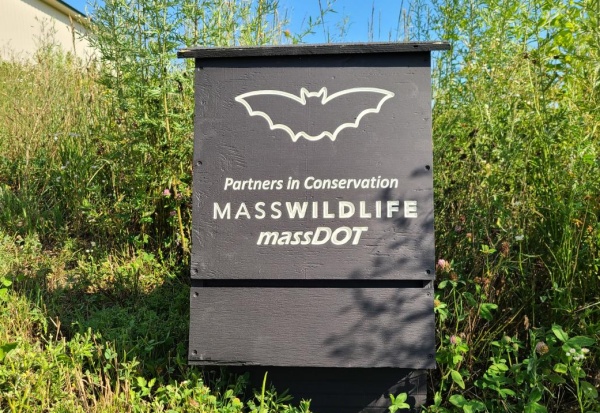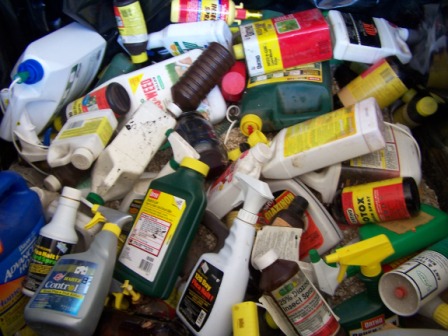Did you know Massachusetts is home to 9 species of bats and 5 of them are considered endangered? You can help bats by putting up a bat house yourself or volunteering to monitor a bat house on one of our properties!
April 17 is International Bat Appreciation Day. Throughout Massachusetts there are nine species of bats, five of which are considered endangered. Currently, one of the greatest threats to bats is White-nose Syndrome (WNS), a fungal disease that has caused devastating mortality of bats that spend their winters hibernating in caves and mines. Bat houses provide clean homes for bats that are free of white-nose syndrome.

Bat box at Frances Crane WMA. Division of Fisheries and Wildlife photo.
In 2020, MassWildlife launched a new effort to construct and install bat houses to raise awareness about the important role bats play in our environment and get more bat houses out on the landscape. Artificial roost sites (like bat houses) are tools for mitigation, conservation, and habitat enhancements for sensitive bat species. Properly constructed and strategically placed bat houses can be an important tool in assisting bat survival.
In late 2020 and early 2021, MassWildlife installed 30 bat houses on MassWildlife Wildlife Management Areas (WMAs) and other MassWildlife properties. 16 citizen scientists monitored 19 of these bat houses once a month in June, July, and August 2021. The results of the 2021 volunteer monitoring effort confirmed that three bat houses were occupied, and an additional five locations had guano (bat droppings) nearby or bats observed flying in the area but had not yet taken up residency in the bat houses. It can take up to two years for bats to move into a bat house, and even then, only about 15% of bat houses are typically occupied. The first year alone of this project resulted in 16% occupancy and another 26% of the locations monitored showed promising potential for future occupancy.

Bat box at Mill Brook Bogs WMA. Division of Fisheries and Wildlife photo.
Get involved with bat conservation
• Build a bat house: One of the best ways you can support bat conservation is to put up an artificial roost, like a bat house. Bat houses give females a safe, warm place to raise their young. Since most female bats only have one pup each year, bat populations grow very slowly. Additionally, due to habitat loss and degradation, it is becoming harder for bats to locate natural roost sites to raise their young. Installing a bat house on your property can provide a safe environment for bats, while protecting your yard from pest insects, like mosquitoes, moths, and beetles. Bat houses can be purchased, or you can build your own. You can find a guide to bat houses on MassWildlife’s website, including plans for building a bat house, installation tips, and advice for attracting bats to your bat house.
• Become a volunteer bat monitor: MassWildlife is looking for volunteers to help monitor bat houses installed on Wildlife Management Areas across the state. No special bat experience required! Monitors will be asked to visit the site of their assigned bat house at least once a month during June, July, and August, and report to MassWildlife if bats are present. Volunteers must have their own transportation to the site and be able to navigate using a set of GPS coordinates. Prospective volunteers should fill out this application form no later than May 13. MassWildlife will contact you with details if a bat house is in need of a monitor in your area. If you aren’t able to participate in our volunteer monitoring program, you can still be a citizen scientist by reporting any bat colonies to MassWildlife using this form.

Close-up of the bat box before installation. Division of Fisheries and Wildlife photo.
• Create habitat for bats: Bats seek shelter under peeling bark on dead trees. If you have dead or dying trees on your property, leave them standing as potential roost sites for bats. You can also create a bat-friendly landscape in your backyard by adding night-scented flowers and water features such as a pond.
• Reduce pesticide use: Pesticides make it difficult for bats to find healthy food to eat. Insecticides can cause bats to go hungry from the lack of insects available.
For more information on WNS and other threats to bats, see MassWildlife’s webpage on bat mortality in Massachusetts.
 New Bedford Guide Your Guide to New Bedford and South Coast, MA
New Bedford Guide Your Guide to New Bedford and South Coast, MA









